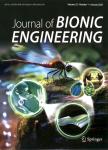Prototype Design and Experimental Study on Locust Air-Posture Righting
Prototype Design and Experimental Study on Locust Air-Posture Righting作者机构:Robotics Institute Beihang University Beijing 100191 P. R. China
出 版 物:《Journal of Bionic Engineering》 (仿生工程学报(英文版))
年 卷 期:2014年第11卷第3期
页 面:459-468页
核心收录:
学科分类:0821[工学-纺织科学与工程] 08[工学] 09[农学] 0904[农学-植物保护] 090402[农学-农业昆虫与害虫防治] 082104[工学-服装设计与工程]
基 金:Acknowledgment This work was supported by the National Natural Science Foundation of China (No.51075014 and No.51375035) the Research Fund for the Doctoral Program of Higher Education of China (No.20121102110021)
主 题:attitude adjustment locust air-posture righting prototype design wiggling tail flapping wing
摘 要:Locust has the capacity to maintain a righting posture and glide through attitude adjustment after leaping. A prototype inspired by the dynamic mechanism of attitude adjustment of locusts was developed. The prototype consists of a pair of wings driven by a four-bar mechanism, and a 2 Degree of Freedom (DOF) tail to imitate the movement of the locust abdomen. The power source, microcontroller, wireless data transmission module, and attitude sensors are contained in the fuselage. Experiments imitating the flight of locust were conducted to determine the mechanism of locust Subsequent Attitude Adjustment (SAA). The tethered prototype was driven by the movement of the tail and the flapping of the wings. Results show that the pitch and yaw of the tail, and the asymmetric action of the flapping wings significantly influence the posture of the prototype. These findings suggest that both the wiggling abdomen and flapping wings contribute to the locust SAA in the air. This research lays the groundwork and technical support for the probable design and development of practical jumping robots with attitude adjustment function.




